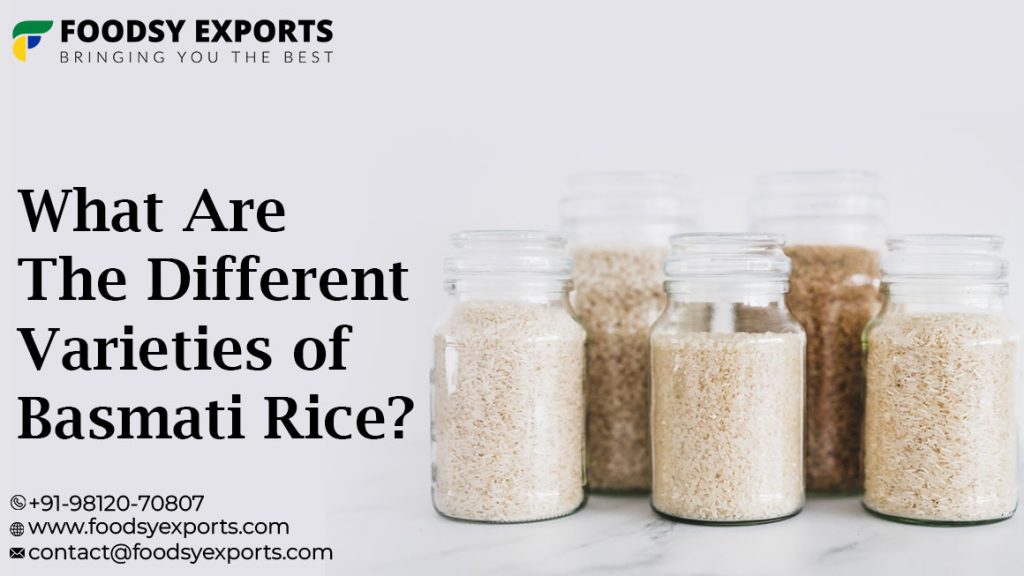Rice, the unsung hero of our plates, weaves a tale that goes beyond mere sustenance. Beyond its humble grains lies a rich narrative, deeply rooted in cultures worldwide. As the world’s most consumed staple, rice isn’t just about filling our bellies; it’s a cultural cornerstone, a symbol of tradition, and an economic force. From the fragrant basmati fields to the bustling paddy terraces, rice transcends its role as a mere grain—it’s a story we all share, a journey on our plates that unfolds in every satisfying bite.
Rice – Staple Food
All over India, people eat rice every day. India grows a lot of rice, which is one of their main grains. The country has the most land used to grow rice. Depending on the area, different ways are used to grow rice. Rice is grown in places that get a lot of rain every year. All over India, rice is a common food.
Different Varieties of Basmati Rice with its characteristics
1. 1121 Basmati Rice
1121 Basmati Rice is a type of long-grain white rice that is widely popular in the Indian subcontinent. It is known for its aromatic flavor, tender texture, and distinct elongated grains. Basmati rice is typically grown in the northern regions of India and Pakistan, and is often associated with traditional Indian cuisine and festivals. It is commonly used as a base for biryanis, curries, and other dishes.
Uncooked 1121 Basmati Rice measuring between 8.30 and 8.40 mm. Once cooked, this variety outshines others by expanding 30% more in volume. Witness the magic in the pot as 1121 Basmati rice grows 2.5 times longer, reaching an impressive length of up to 22 mm and expanding over four times its original size.
Basmati rice has a unique smell, a sweet taste, and is very healthy. When cooked, basmati rice’s extra-long, thin grains stretch out at least twice as much as they were before. This gives the rice a soft, fluffy texture.
2. 1718 Basmati Rice
The Basmati 1718 rice seed has been genetically changed to not get bacterial leaf blight. In addition, it won’t get flat during rain, hail, or strong winds. The seed for 1718 Basmati rice has been changed from the seed for 1121 Basmati rice.
Let’s talk about Basmati 1718 in more depth:
- Delhi, Punjab, and Haryana are all good places to grow it.
- From May 14 to June 20, you can plant it.
- After planting, it takes about 136–138 days for the crop to be ready to be picked.
- About 18–20 quintals of fruit are grown from it every acre.
- It has long, thin grains that are 8.1 mm long and a 17.0 mm long seed.
3. 1401 Basmati Rice
1401 Basmati rice is a mixed type of rice that smells good and produces a lot of rice. It is the first type of Basmati rice that grows early.
Here are some other characteristics of 1401 Basmati rice:
- Nutritional value: 1401 Basmati rice is popular for its high nutritional value and antioxidant properties.
- Purity: 1401 Basmati rice is 100% pure.
- Grain length: 1401 Basmati rice is shorter than Basmati 1121 rice, but its grains retain their shape after cooking.
- Shelf life: 1401 Basmati rice is non-sticky after cooking and has a longer shelf life.
4. 1509 Basmati Rice
1509 Basmati rice is a type of Basmati rice that is cooked quickly. Between 115 and 120 days, the seeds sprout and grow into plants. The average yield is 4.25 to 6.5 tons per acre.
- The grains in Basmati rice are known to be very long and thin, sometimes up to 8.5 mm long. The grains can be 18–20 mm long when they are cooked. Additionally, the rice smells good and is very good for you.
- Because it grows faster and produces more, 1509 Basmati rice is less expensive than 1121 Basmati rice. Some people, though, say that 1121 Basmati rice tastes better and is fuller after being cooked.
- People eat basmati rice every day, both at home and in restaurants and canteens. It comes in PP, BOPP, jute, and non-woven bags.
5. Pusa Basmati Rice
A modified; half-dwarf form of Basmati rice is called Pusa Basmati Rice. “Todal” is another name for it. Pusa Basmati Rice smells, tastes, and has an alkaline content that are the same as or better than regular Basmati rice.
For every acre of land, Pusa Basmati 1121 produces 19–20 quintals of rice, while standard Basmati only produces 9–10 quintals.
- When it’s ready: Pusa Basmati Rice is ready in 115 to 120 days and produces an average of 5.5 to 6 tons per acre.
- Needs Water: Pusa Basmati 1121 needs less water than other traditional Basmati types and is ready to harvest earlier.
- Yield of grains: Pusa Basmati 1121 could produce 5 tons of grains per acre.
- Time to cook: Pusa Basmati 1121 takes less time to cook and has longer, straighter kernels when they’re done than other types.
- Not sticky: Once cooked, Pusa Basmati Rice doesn’t stick together.
6. Traditional Basmati Rice
Traditional Basmati rice is a high-quality type of flavorful rice that is grown in Nepal, Pakistan, and India. One thing that makes it stand out is its unique flavor and even structure. It gets soft and doubles in size when it’s cooked.
- Length: The grains are 7.03 mm long, which makes it longer and fluffier than other Indian Basmati types.
- Aroma: Because of its beautiful smell, it is often called the “Queen of Fragrances.”
- Nutrients: Full of protein, high in fiber, and low in fat.
Keep it out of the sun and in a cool, dry place.
Conclusion
Looking for the best rice with different varieties of basmati range? FOODSY EXPORTS is the one you can trust with your choice of basmati rice.
Contact Details
Name: Foodsy Exports
Call: +91-9812070807
Mail: contact@foodsyexports.com
Address: 152, New Grain Market, Jagahdri, Haryana (135001), INDIA




